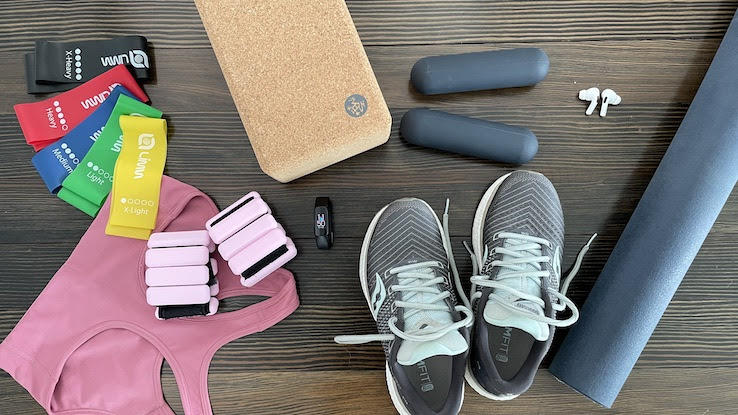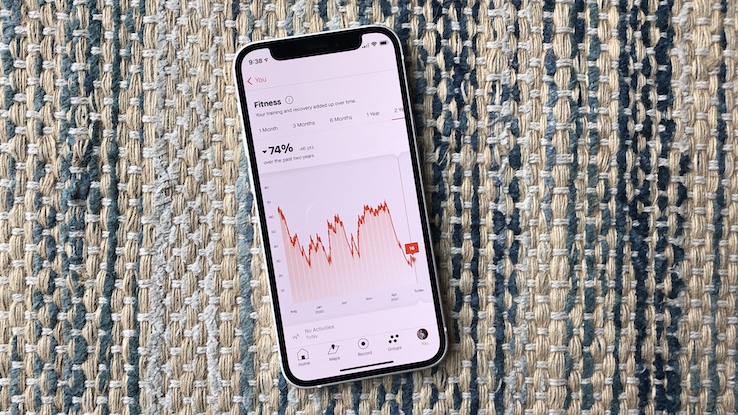
At the beginning of the year, I wrote about my running challenge for 2021, which wasn’t that ambitious. The pandemic had created havoc when it came to my running regimen — and exercise routine in general in 2020 — and my main goal was to run more in 2021 than I had in 2020. Ideally, I would have liked to get back into my 2019 shape. That year, and the previous five, I had run a half marathon during the summer, which shaped my training for the whole year and ensured I kept in decent shape most of the time.
Things looked bright at the beginning of 2021. I was exercising pretty much every day, either doing a Pilates or barre session, going for a short run or simply taking a long walk. You can call it new year’s resolutions. I call it “vaccine promise on the horizon.” I pretty much kept up a seven-day-a-week exercise habit until April. The whole thing was becoming a bit obsessive. I had an Apple Watch at the time and to make sure I was closing my Move Ring, which I had set to a mildly challenging 600 active calories per day, I was sometimes walking — even running — on my treadmill at 10 pm. The idea was to arrive in good shape to the long-awaited and promised hot vax summer — my version of it consisted of returning to the yoga studio, going to the movies every week and catching a few plays — and from there just ease back into my previous life and exercise customs.
My subconscious must have realized before I did that things weren’t going back to normal at all. At some point in May, I almost completely stopped training. That’s something that hardly happened to me pre-COVID but has been a constant during the pandemic. Whenever I think I have a consistent routine, something forces me out of it. Be it a fire season that makes it impossible to go outside, losing my previous job or simply hitting another pandemic wall. Staying motivated and focused has remained harder than ever during the last 18 months.
A couple of weeks ago I realized I needed to shake this latest inactivity strike and get moving. After finally going for a run for the first time in more than a month, and feeling every part of it, I opened the running app Strava — I’ve been a somewhat regular user since 2014 — and checked my Fitness score. That’s one of the many statistics the social media network for active people provides. They define Fitness as a number that “assigns a score to your current fitness and compares that to where your fitness has been over the past month, three months, six months, year and two years.” To calculate it, they use data about your training load and the relative effort employed during your workouts.
In the past and while at the peak of my half marathon training, I’ve had scores of 73 and even 83. (I’m not sure what the maximum score is, but I think Strava feels you should just measure your past and present selves against each other.) My maximum Fitness number over the last two years has been 64, and in April of this year I was at 57. I’m now at a paltry 16 after having fallen as low as 11 a couple of weeks ago, the lowest number I’ve seen by far. And even if I know I should probably take these numbers with a grain of salt, the reality is that I’ve been slacking for weeks months and it shows.
Tips to Stay Motivated

Confronting the hard reality of my Fitness score made me realize I had to take action. And I’m trying to slowly get back on track. Here are a few suggestions if you also are struggling and trying to keep some of your fitness goals intact during pandemic times. It’s not easy, but some of these methods have worked for me in the past:
Schedule your training sessions on your calendar. That’s one of the ways that works best for me. I schedule my workout sessions at the beginning of the week for the remainder of it and add those sessions both to my personal and work calendars. It’s a good way to avoid last-minute, ill-timed meetings. Of course, like with everything else, I’m flexible. And things can be moved around if something important comes up at work or in life. But too many exceptions tend to mean I’m procrastinating.
Make an event out of it. Since we’re not doing that much anyway, making my workout sessions some kind of date with myself has helped to break the routine of endless days working from home. I also enjoy dressing up for a quick run or a virtual live Pilates session.
Enrolling in live remote classes has also encouraged me to be more accountable. For some bizarre reason, even if the instructor has no way of seeing me, chances are if it’s a live session I’ll suffer through the whole plank. If I’m doing a pre-taped class, I won’t.
My colleague Caleb Bailey told me he stops looking at social media influencers who just have a 5% body fat and I also started applying that maxim. I mean, you can still browse through J. Lo’s Instagram account, but I already gave up on the idea of achieving anything close to those goddess’ abs.
Precisely because of that, just adjust your expectations and don’t pretend to be back where you were a few weeks or months ago. The first day you return to working out, it’s going to be hard. You’ll be sore the next day. Just have that in mind. It’ll get better.
And most importantly: never feel guilty about it. Anything of it, really. We’re all on the same page and things have to start getting a bit easier at some point. Right?
If you enjoyed this story, or identified with it in any way, check out my failed attempt at a 30-day yoga challenge from earlier this year.





